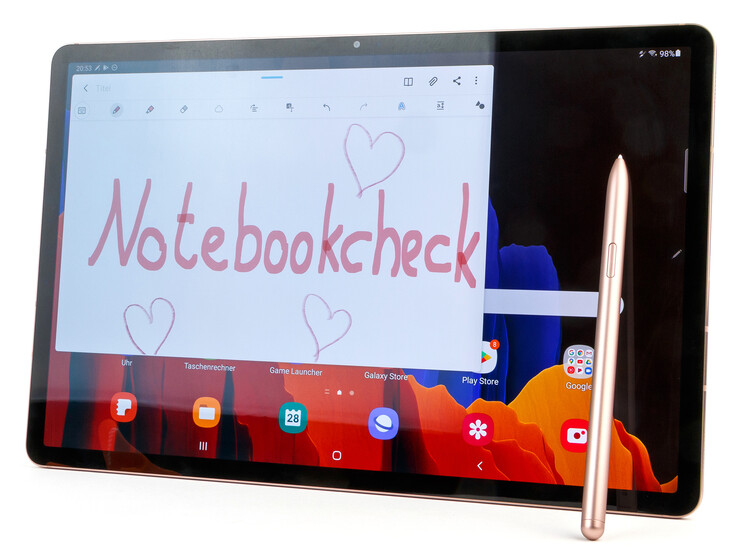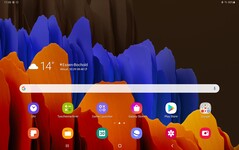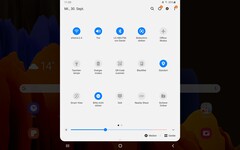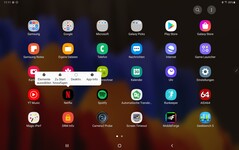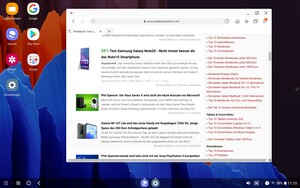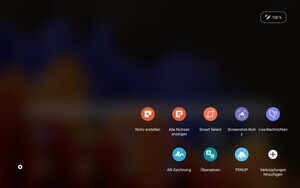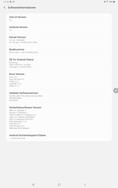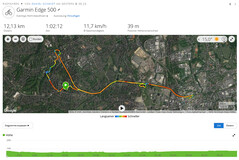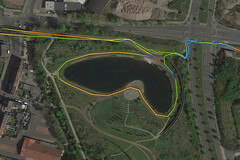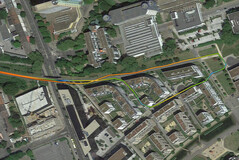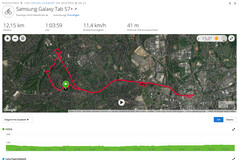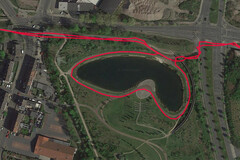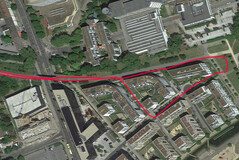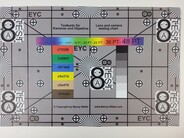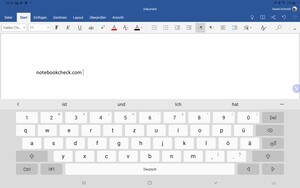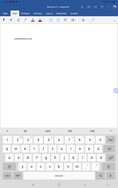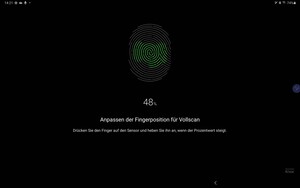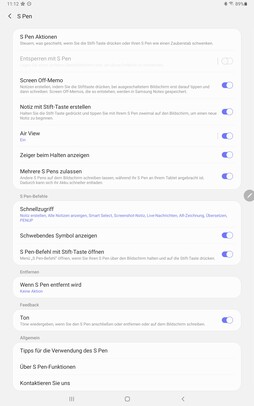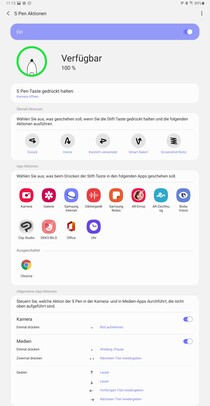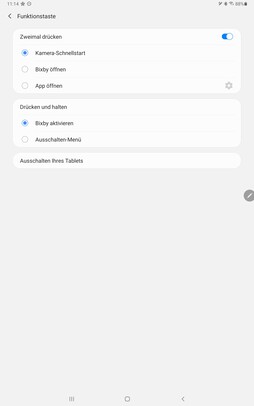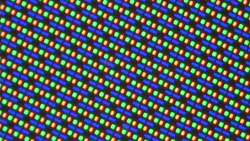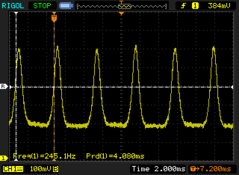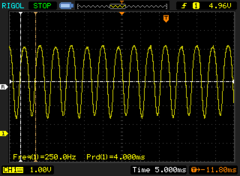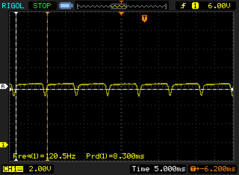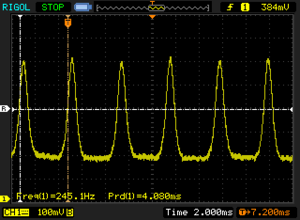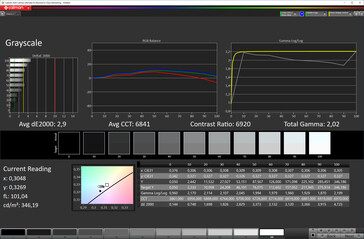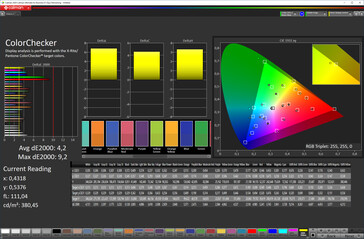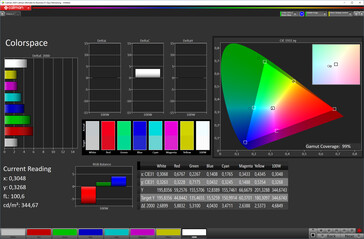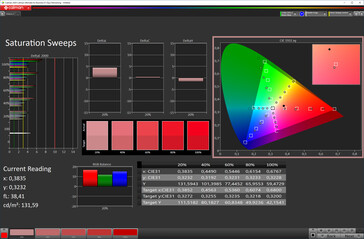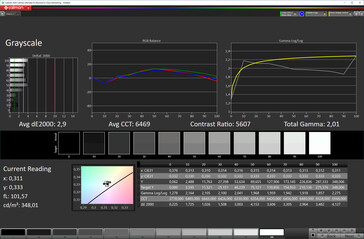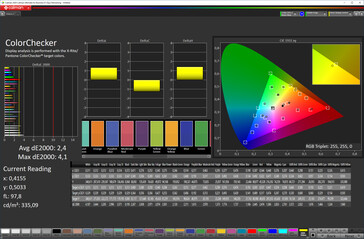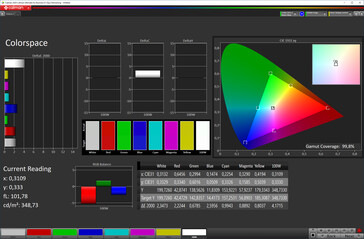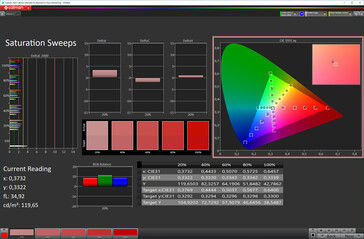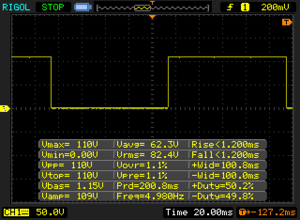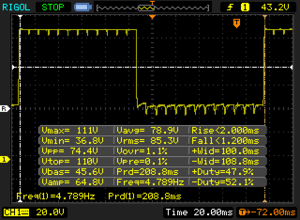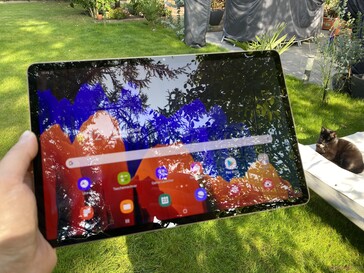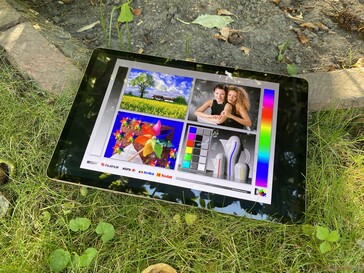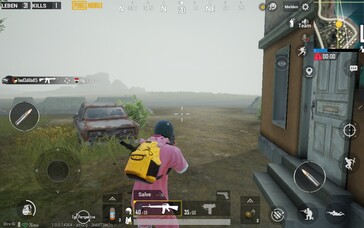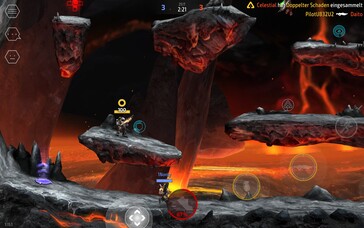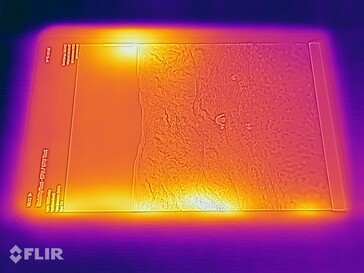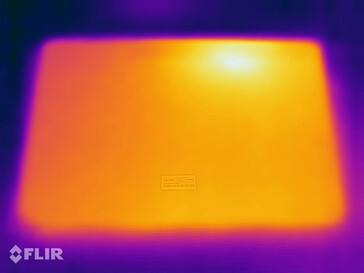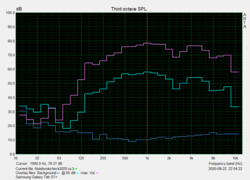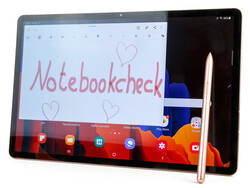Samsung Galaxy Tab S7 Plus Review - Finally a great Android tablet
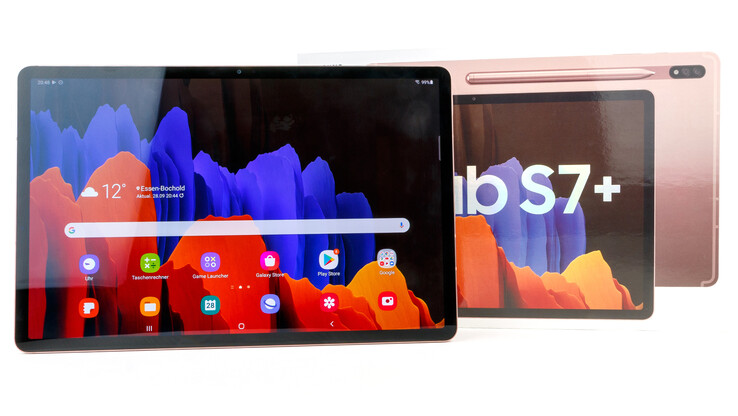
The Samsung Galaxy Tab S7+ offers a great level of performance. It is powered by the Snapdragon 865+ and has 8 GB of RAM. All models feature 256 GB of internal memory. Both the smaller Tab S7 and the S7+ come with an optional 5G modem. Our review device has an OLED panel, whereas the smaller tablet comes with a PLS screen.
The prices for the Wi-Fi version of the Galaxy Tab S7 Plus start at 954 Euros (~$1117). The 5G model costs 1149 Euros (~$1346). For comparison: The Wi-Fi version of the iPad Pro 12.9 with the same memory configuration retails for 1179 Euros (~$1381) - without the stylus.
With the Tab S7+, Samsung is going hard after Apple. The Tab S7+ also represents the first big Samsung tablet since the release of the Galaxy Note Pro 12.2 (2014) and the Galaxy View (18.4-inches, 2016).
Rating | Date | Model | Weight | Height | Size | Resolution | Price |
|---|---|---|---|---|---|---|---|
| 88.1 % v7 (old) | 10 / 2020 | Samsung Galaxy Tab S7 Plus SD 865+ (Plus), Adreno 650 | 575 g | 5.7 mm | 12.40" | 2800x1752 | |
| 89.3 % v7 (old) | 05 / 2020 | Apple iPad Pro 12.9 2020 A12Z Bionic, A12Z Bionic GPU | 641 g | 5.9 mm | 12.90" | 2732x2048 | |
| 88.4 % v7 (old) | 08 / 2020 | Huawei MatePad Pro 10.8 Kirin 990, Mali-G76 MP16 | 460 g | 7.2 mm | 10.80" | 2560x1600 | |
| 87.8 % v7 (old) | 10 / 2019 | Samsung Galaxy Tab S6 SM-T860 SD 855, Adreno 640 | 420 g | 5.7 mm | 10.50" | 2560x1600 |
Case - The slim Tab S7+ is made of glass and aluminium
The housing of the Tab S7+ is made of a solid piece of aluminium. There are three colour schemes on offer: Mystic Black, Mystic Bronze and Mystic Silver. The camera bump on the back is so small that it is barely noticeable. All in all, the camera system protrudes 1.25 millimetres from the back. The display is protected with Corning Gorilla Glass 3.
The design of the Samsung tablet is quite angular. Nevertheless, the slate is comfortable to hold in the hand. The build quality is on a very good level. There are no chinks or gaps anywhere. Because of its design, the Tab S7+ can be bent. It also produces a creaking noise when it is being twisted. Aside from that, the tablet feels very solid.
The card slot of our bronze-coloured device is slightly recessed into the mid-frame and has a slightly different colour than the rest of the tablet. The card tray is made of plastic and can take one microSD card and one nanoSIM card. However, the slot for the nanoSIM card is occupied by a black piece of plastic in our Wi-Fi model. The tablet is neither water- nor dust-proof and the battery is not removable. The S Pen, which is made of plastic, can magnetically attach to the back of the device and charges via induction.
Connectivity - DeX with and without a cable
The storage capacity of the Galaxy Tab S7+ can be expanded by up to 1 TB with the help of a microSD card. SD cards cannot be formatted as internal storage. However, they can be used to store application data. Thanks to exFAT, very large files can be stored on the tablet.
The USB 3.2 (Gen 1) port offers data transfer rates of up to 5 Gb/s and can output a 1080p video signal with the help of an adapter. Samsung DeX is also on board. It can be used directly on the tablet or on an external display through a wired or wireless connection. Miracast is utilised for a wireless connection. Even though it works well in general, there are still some latency issues. It is good enough for making a presentation. However, for either gaming or work, we recommend using a wired connection.
The connector on the bottom is intended for the BookCover Keyboard, which attaches magnetically.
Software - Galaxy tablet with promises of updates
The Galaxy Tab S7+ runs Android 10. The security patches were last updated in September, 2020. According to Samsung, users of the Tab S7+ should receive timely software update.
The Samsung slate comes with Samsung’s Galaxy Store in addition to Google’s Play Store. Moreover, Microsoft’s applications, Netflix, Facebook and Spotify are preinstalled. These cannot be fully uninstalled. They can only be disabled.
The S Pen brings functionality to the Tab S7+ that we already saw in the Note 20 devices and their predecessors. Kids Mode and Samsung DeX round off the software package.
Communication and Geolocation - Slow and unstable Wi-Fi
The Tab S7+ has a Wi-Fi 6 modem with a MIMO antenna array. It also supports VHT80 networking. Nevertheless, the Tab S7+ does poorly in the Wi-Fi benchmarks, which we conduct with our reference-grade router Netgear Nighthawk AX12. The data transfer rates are lower than expected and we also observed significant drops in performance. However, these should not be noticeable in day-to-day use, because the data transfer rates of over 240 Mb/s are still very high and most modern Internet connections cannot even achieve such speeds. Howbeit, Samsung should try to improve Wi-Fi performance through an update. The signal attenuation of -37 dBm is on a good level.
The model with a cellular modem (SM-T976) can operate in 5G networks. The microphones worked rather well during our test video conference. The participants described our voice as a little too quiet.
| Networking | |
| iperf3 transmit AX12 | |
| Huawei MatePad Pro 10.8 | |
| Apple iPad Pro 12.9 2020 | |
| Samsung Galaxy Tab S7 Plus | |
| Samsung Galaxy Tab S6 SM-T860 | |
| iperf3 receive AX12 | |
| Huawei MatePad Pro 10.8 | |
| Samsung Galaxy Tab S6 SM-T860 | |
| Samsung Galaxy Tab S7 Plus | |
| Apple iPad Pro 12.9 2020 | |
The Samsung slate supports only the following global navigation satellite systems: GPS, Glonass and BeiDou. Dual-band GNSS is not supported. Indoors, our review device struggles to establish a connection with the satellites and has a margin of error of 24 to 32 metres. Outdoors, the Tab S7+ determines the user’s location quickly and accurately.
In order to determine how accurate our review device is when it comes to geolocation, we take it with us on a bike ride. During this ride, we are also accompanied by the professional navigator Garmin Edge 500. The Tab S7+ proves to be almost as accurate as our reference-grade navigator. However, the route that we took was not mapped perfectly on the Android tablet. Despite its modest GNSS module, the Tab S7+ does surprising well when it comes to navigation.
Cameras - Samsung tablet with a solid dual-camera setup
The 8-megapixel front-facing camera (Samsung S5K4HA, 1/4", 1.12 μm) of the Tab S7+ produces solid photographs and offers the same features as Samsung’s smartphones. It can record video at 1080p30. The video quality is good enough for video calls. However, the photographs look muddy and washed-out.
The dual-camera system on the back consists of a 13-megapixel main sensor (Samsung S5K3M5, 1/3.4", 1,0 μm) and a 5-megapixel ultra wide-angle lens. The shots taken with the main camera appear well-exposed. However, fine details are lost and the colours are difficult to tell apart. The ultra wide-angle camera produces good images despite its low resolution. However, the edges of the photographs are marred by chromatic aberration. The tablet is not designed for taking snapshots. Howbeit, it is good enough for photographing documents and taking occasional pictures.
The rear camera can shoot video at 2160p30.
Image comparison
Choose a scene and navigate within the first image. One click changes the position on touchscreens. One click on the zoomed-in image opens the original in a new window. The first image shows the scaled photograph of the test device.
Wide-angleWide-angleUltra Wide-angle5X zoomLow-light photography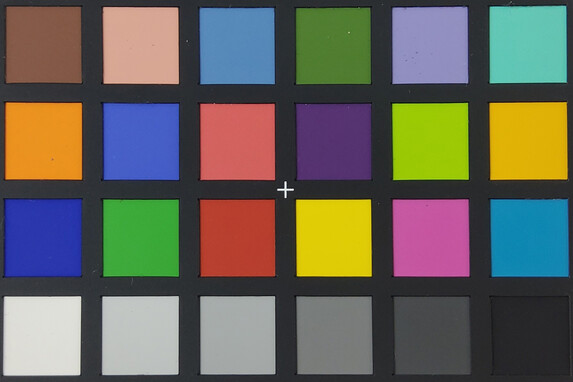
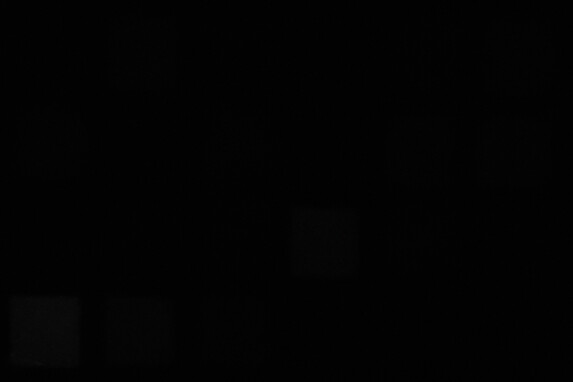
Accessories & Warranty - Tablet with an optional keyboard
The premium tablet comes with a 24-month warranty, which can be enhanced with a Care+ package. It protects the device from accidental damage and costs 149 Euros (~$174). It covers two accidents and has a 59-Euro (~$69) service fee.
The box contains the Galaxy Tab S7+, a modular 15-watt charger, a USB cable (1 m, Type-A to Type-C), the S Pen, a SIM card removal tool and safety and warranty information.
Samsung sells the BookCover Keyboard for 224.10 Euros (~$262.58) and the BookCover (without the keyboard) for 77.88 Euros (~$91.25).
Input Devices & Handling - Fingerprint sensor under the screen
Whether you use your fingers or the included S Pen, the touchscreen of the Tab S7+ recognises inputs quickly and accurately. Thanks to the fast SoC and a high refresh rate, the system performance of the Samsung slate is on a very good level.
The S Pen offers all current features and supports 4,096 pressure levels. It can be used for note-taking, drawing or even making presentations. The hardware button is remappable and can be used to do more than just call up Bixby.
The Android tablet features an in-screen fingerprint scanner and supports face recognition. Both functioned well in our review. The fingerprint reader is very cleverly positioned on the right side, which is why it is easy to reach when you use the tablet in landscape mode. However, the fingerprint sensor does not work very fast when the screen is off.
Display - Old technology with DC dimming
The 12.4-inch (31.5-cm) Super AMOLED display of the Galaxy Tab S7+ has a native resolution of 2800x1752 pixels. The pixel density is a little lower than what the Galaxy Tab S6 has to offer. However, the Tab S7+ has a 120-Hz refresh rate.
We were expecting to see a higher brightness. With the ambient light sensor enabled, the panel has an average brightness of 447 cd/m². With the light sensor disabled, the screen brightness peaks at 342 cd/m². The screen can become even brighter in manual mode, if the slate is in a very bright environment. The Tab S7+ supports HDR10 and HDR10+. In the APL50 test, in which the screen displays a pattern of alternating black and white squares of equal size, we measured a brightness of 541 cd/m². This measurement reveals that the panel of the Tab S7+ is not bright enough for a perfect HDR experience.
Positive: The Samsung tablet supports DC dimming. According to our oscilloscope measurements, the OLED screen flickers from 235.8 to 245.1 Hz at minimum brightness. As long as the brightness level remains below 20%, the panel flickers from 238 to 250 Hz. At 20% brightness and above, the PWM frequency amounts to a constant 120 Hz.
| |||||||||||||||||||||||||
Brightness Distribution: 98 %
Center on Battery: 441 cd/m²
Contrast: ∞:1 (Black: 0 cd/m²)
ΔE ColorChecker Calman: 2.4 | ∀{0.5-29.43 Ø4.79}
ΔE Greyscale Calman: 2.9 | ∀{0.09-98 Ø5}
99.8% sRGB (Calman 2D)
Gamma: 2.01
CCT: 6469 K
| Samsung Galaxy Tab S7 Plus Super AMOLED, 2800x1752, 12.4" | Apple iPad Pro 12.9 2020 IPS, 2732x2048, 12.9" | Huawei MatePad Pro 10.8 IPS, 2560x1600, 10.8" | Samsung Galaxy Tab S6 SM-T860 Super AMOLED, 2560x1600, 10.5" | |
|---|---|---|---|---|
| Screen | 31% | -10% | -5% | |
| Brightness middle (cd/m²) | 441 | 625 42% | 606 37% | 446 1% |
| Brightness (cd/m²) | 447 | 599 34% | 579 30% | 445 0% |
| Brightness Distribution (%) | 98 | 87 -11% | 89 -9% | 86 -12% |
| Black Level * (cd/m²) | 0.47 | 0.32 | ||
| Colorchecker dE 2000 * | 2.4 | 1.3 46% | 2.9 -21% | 2.7 -13% |
| Colorchecker dE 2000 max. * | 4.1 | 2.7 34% | 6 -46% | 5.4 -32% |
| Greyscale dE 2000 * | 2.9 | 1.8 38% | 4.3 -48% | 2.1 28% |
| Gamma | 2.01 109% | 2.23 99% | 2.22 99% | 2.05 107% |
| CCT | 6469 100% | 6765 96% | 7272 89% | 6468 100% |
| Contrast (:1) | 1330 | 1894 |
* ... smaller is better
Screen Flickering / PWM (Pulse-Width Modulation)
| Screen flickering / PWM detected | 245.1 Hz | ≤ 1 % brightness setting | |
| ≤ 1.73 cd/m² brightness | |||
The display backlight flickers at 245.1 Hz (worst case, e.g., utilizing PWM) Flickering detected at a brightness setting of 1 % (1.73 cd/m²) and below. There should be no flickering or PWM above this brightness setting. The frequency of 245.1 Hz is relatively low, so sensitive users will likely notice flickering and experience eyestrain at the stated brightness setting and below. As the flickering occurs only on very low brightness settings, it should not be an issue in typical office settings. Nonetheless, use in low light conditions may be straining to the eyes. In comparison: 53 % of all tested devices do not use PWM to dim the display. If PWM was detected, an average of 8167 (minimum: 5 - maximum: 343500) Hz was measured. | |||
Our CalMAN test reveals that the screen of the Galaxy Tab S7+ is very colour-accurate in Natural
mode, which clamps the gamut to the sRGB colour space. The colour reproduction is also quite good in Vivid
mode. However, the Delta E 2000 colour deviations are significantly lower in Natural
Mode.
Display Response Times
| ↔ Response Time Black to White | ||
|---|---|---|
| 2.4 ms ... rise ↗ and fall ↘ combined | ↗ 1.2 ms rise | |
| ↘ 1.2 ms fall | ||
| The screen shows very fast response rates in our tests and should be very well suited for fast-paced gaming. In comparison, all tested devices range from 0.1 (minimum) to 240 (maximum) ms. » 11 % of all devices are better. This means that the measured response time is better than the average of all tested devices (20.3 ms). | ||
| ↔ Response Time 50% Grey to 80% Grey | ||
| 3.2 ms ... rise ↗ and fall ↘ combined | ↗ 2 ms rise | |
| ↘ 1.2 ms fall | ||
| The screen shows very fast response rates in our tests and should be very well suited for fast-paced gaming. In comparison, all tested devices range from 0.165 (minimum) to 636 (maximum) ms. » 12 % of all devices are better. This means that the measured response time is better than the average of all tested devices (31.7 ms). | ||
Outdoors, the Tab S7+ leaves a rather mixed impression. The superb contrast ratio ensures readability on cloudy days. However, screen reflections make the display difficult to read, especially when it is viewed at an angle. In any case, the OLED panel is not bright enough to be legible on sunny days. Howbeit, the display can be comfortably read in the shade.
Performance - Galaxy Tab with Snapdragon 865+
The Tab S7+ comes with the Snapdragon 865 Plus, which is supposed to offer 10% more performance than the conventional SD 865. The high-performance Prime core can reach up to 3.1 GHz. The Adreno 650 serves as the GPU.
In Geekbench, the Galaxy Tab S7+ achieves a good single-core score. Nevertheless, it is still beaten by the iPad Pro. In the multi-core benchmarks, the Tab S7+ performs surprisingly poorly. Here, smartphones with the Snapdragon 865 are around 10% faster than the Samsung slate. We think that this is due to a poor cooling solution. In the Physics section of the 3DMark benchmark, the S7+ does even worse. However, in the GPU benchmarks, the Samsung tablet is 4 to 7% faster than other devices.
| Geekbench 4.4 | |
| 64 Bit Single-Core Score | |
| Average of class Tablet (853 - 9867, n=15, last 2 years) | |
| Average Qualcomm Snapdragon 865+ (Plus) (n=1) | |
| Huawei MatePad Pro 10.8 | |
| 64 Bit Multi-Core Score | |
| Average of class Tablet (2498 - 30983, n=15, last 2 years) | |
| Average Qualcomm Snapdragon 865+ (Plus) (n=1) | |
| Huawei MatePad Pro 10.8 | |
| Compute RenderScript Score | |
| Average of class Tablet (2128 - 22243, n=8, last 2 years) | |
| Average Qualcomm Snapdragon 865+ (Plus) (n=1) | |
| Huawei MatePad Pro 10.8 | |
| PCMark for Android | |
| Work performance score | |
| Average Qualcomm Snapdragon 865+ (Plus) (13629 - 19824, n=5) | |
| Samsung Galaxy Tab S7 Plus | |
| Samsung Galaxy Tab S6 SM-T860 | |
| Huawei MatePad Pro 10.8 | |
| Work 2.0 performance score | |
| Average Qualcomm Snapdragon 865+ (Plus) (12355 - 14979, n=6) | |
| Samsung Galaxy Tab S7 Plus | |
| Samsung Galaxy Tab S6 SM-T860 | |
| Huawei MatePad Pro 10.8 | |
| GFXBench 3.0 | |
| on screen Manhattan Onscreen OGL | |
| Average Qualcomm Snapdragon 865+ (Plus) (60 - 117, n=5) | |
| Samsung Galaxy Tab S7 Plus | |
| Average of class Tablet (14 - 165, n=76, last 2 years) | |
| Samsung Galaxy Tab S6 SM-T860 | |
| Huawei MatePad Pro 10.8 | |
| 1920x1080 1080p Manhattan Offscreen | |
| Average of class Tablet (12 - 532, n=76, last 2 years) | |
| Average Qualcomm Snapdragon 865+ (Plus) (110 - 134, n=5) | |
| Samsung Galaxy Tab S7 Plus | |
| Samsung Galaxy Tab S6 SM-T860 | |
| Huawei MatePad Pro 10.8 | |
| GFXBench 3.1 | |
| on screen Manhattan ES 3.1 Onscreen | |
| Average Qualcomm Snapdragon 865+ (Plus) (41 - 82, n=5) | |
| Average of class Tablet (8.4 - 160, n=76, last 2 years) | |
| Samsung Galaxy Tab S7 Plus | |
| Samsung Galaxy Tab S6 SM-T860 | |
| Huawei MatePad Pro 10.8 | |
| 1920x1080 Manhattan ES 3.1 Offscreen | |
| Average of class Tablet (8.3 - 400, n=76, last 2 years) | |
| Average Qualcomm Snapdragon 865+ (Plus) (75 - 93, n=5) | |
| Samsung Galaxy Tab S7 Plus | |
| Samsung Galaxy Tab S6 SM-T860 | |
| Huawei MatePad Pro 10.8 | |
| AnTuTu v8 - Total Score | |
| Apple iPad Pro 12.9 2020 | |
| Average Qualcomm Snapdragon 865+ (Plus) (490260 - 622888, n=4) | |
| Samsung Galaxy Tab S7 Plus | |
| Huawei MatePad Pro 10.8 | |
We used the default Samsung Internet browser for our browser benchmarks. The Tab S7+ did well in the synthetic benchmarks. Nonetheless, it was unable to beat the iPad Pro. In day-to-day use, the Samsung slate offers a very good Internet-browsing experience.
| Jetstream 2 - 2.0 Total Score | |
| Average of class Tablet (22.3 - 395, n=70, last 2 years) | |
| Apple iPad Pro 12.9 2020 (Safari 13) | |
| Samsung Galaxy Tab S7 Plus (Samsung Browser 12.1) | |
| Average Qualcomm Snapdragon 865+ (Plus) (69.8 - 75.5, n=4) | |
| Samsung Galaxy Tab S6 SM-T860 (Chrome 77.0.3865.116) | |
| Huawei MatePad Pro 10.8 (Huawei Browser V10.1.2) | |
| JetStream 1.1 - Total Score | |
| Apple iPad Pro 12.9 2020 (Safari 13) | |
| Samsung Galaxy Tab S7 Plus (Samsung Browser 12.1) | |
| Average Qualcomm Snapdragon 865+ (Plus) (121.7 - 131.5, n=4) | |
| Samsung Galaxy Tab S6 SM-T860 (Chrome 77.0.3865.116) | |
| Huawei MatePad Pro 10.8 (Huawei Browser V10.1.2) | |
| WebXPRT 3 - Overall | |
| Average of class Tablet (39 - 480, n=27, last 2 years) | |
| Apple iPad Pro 12.9 2020 (Safari 13) | |
| Samsung Galaxy Tab S7 Plus (Samsung Browser 12.1) | |
| Average Qualcomm Snapdragon 865+ (Plus) (114 - 126, n=4) | |
| Samsung Galaxy Tab S6 SM-T860 (Chrome 77.0.3865.116) | |
| Huawei MatePad Pro 10.8 (Huawei Browser V10.1.2) | |
| Speedometer 2.0 - Result 2.0 | |
| Average of class Tablet (2.59 - 790, n=60, last 2 years) | |
| Apple iPad Pro 12.9 2020 (Safari 13) | |
| Samsung Galaxy Tab S7 Plus (Samsung Browser 12.1) | |
| Samsung Galaxy Tab S6 SM-T860 (Chrome 77.0.3865.116) | |
| Average Qualcomm Snapdragon 865+ (Plus) (41.2 - 73.3, n=4) | |
| Huawei MatePad Pro 10.8 (Huawei Browser V10.1.2) | |
| Octane V2 - Total Score | |
| Apple iPad Pro 12.9 2020 (Safari 13) | |
| Average of class Tablet (763 - 138481, n=102, last 2 years) | |
| Samsung Galaxy Tab S7 Plus (Samsung Browser 12.1) | |
| Average Qualcomm Snapdragon 865+ (Plus) (25953 - 27360, n=4) | |
| Samsung Galaxy Tab S6 SM-T860 (Chrome 77.0.3865.116) | |
| Huawei MatePad Pro 10.8 (Huawei Browser V10.1.2) | |
| Mozilla Kraken 1.1 - Total | |
| Average of class Tablet (243 - 27101, n=84, last 2 years) | |
| Huawei MatePad Pro 10.8 (Huawei Browser V10.1.2) | |
| Samsung Galaxy Tab S6 SM-T860 (Chrome 77.0.3865.116) | |
| Samsung Galaxy Tab S7 Plus (Samsung Browser 12.1) | |
| Average Qualcomm Snapdragon 865+ (Plus) (1854 - 1947, n=4) | |
| Apple iPad Pro 12.9 2020 (Safari 13) | |
* ... smaller is better
The Tab S7+ comes with 256 GB of very fast UFS 3.1 memory, which does not do particularly well when it comes to writing 4 KB blocks of data.
In the benchmarks with our reference-grade microSD card (Toshiba Exceria Pro M501), the Tab S7+ achieved good results. However, it was not able to achieve the maximum speeds that our reference-grade SD card offers.
| Samsung Galaxy Tab S7 Plus | Huawei MatePad Pro 10.8 | Samsung Galaxy Tab S6 SM-T860 | Average 256 GB UFS 3.1 Flash | Average of class Tablet | |
|---|---|---|---|---|---|
| AndroBench 3-5 | -2% | -20% | 21% | 21% | |
| Sequential Read 256KB (MB/s) | 1675 | 1789 7% | 1416 -15% | 1742 ? 4% | 1616 ? -4% |
| Sequential Write 256KB (MB/s) | 732 | 399 -45% | 522 -29% | 1191 ? 63% | 1183 ? 62% |
| Random Read 4KB (MB/s) | 230.1 | 224.6 -2% | 191.6 -17% | 286 ? 24% | 233 ? 1% |
| Random Write 4KB (MB/s) | 205 | 262.4 28% | 170.2 -17% | 318 ? 55% | 258 ? 26% |
| Sequential Read 256KB SDCard (MB/s) | 85.8 ? | 82.4 ? -4% | 70.5 ? -18% | 75.9 ? -12% | |
| Sequential Write 256KB SDCard (MB/s) | 69.3 ? | 71.7 ? 3% | 54.5 ? -21% | 61.9 ? -11% |
Gaming - Ready for high-refresh gaming
The Tab S7+ comes with the Adreno 650, which is currently the fastest Android GPU on the market. We use Gamebench to record frame rates for our gaming benchmarks.
The Android tablet proves to be a very capable gaming device. In Armajet, the S7+ manages to hit 120 FPS most of the time. In PUBG Mobile, the slate achieves a stable 40 FPS with the new Ultra HD preset. With the HD preset, the tablet can achieve a rather stable 60 FPS.
The big screen offers an immersive gaming experience. However, because of its size, holding the tablet in the hands for an extended period of time is not going to be easy. The speakers provide a very good sound stage.
PUBG Compare
Emissions - Four powerful speakers in the Galaxy Tab S7+
Temperature
The Tab S7+ does not get hot. Under continuous load, the surface temperatures slightly exceed the 30-°C (86 °F) mark.
We use a battery testing utility known as GFXBench to examine how well our review device performs under sustained load. The battery benchmark is run three times in a row, and both the frame rates and the battery level are recorded. Here, the Tab S7+ gets quite hot under the hood. In the T Rex section of the GFXBench benchmark, the performance drops by more than 10% after the 20th benchmark pass. In the more intensive Manhattan section, the performance declines slowly. However, the overall drop in performance is not as large.
(+) The maximum temperature on the upper side is 32.3 °C / 90 F, compared to the average of 33.7 °C / 93 F, ranging from 20.7 to 53.2 °C for the class Tablet.
(+) The bottom heats up to a maximum of 28 °C / 82 F, compared to the average of 33.2 °C / 92 F
(+) In idle usage, the average temperature for the upper side is 24 °C / 75 F, compared to the device average of 30 °C / 86 F.
Speakers
There are two speakers on either side of the Tab S7+, which were tuned by AKG. They offer a very wide sound stage. However, the bass is almost completely missing.
The slate does not have a headphone jack and there is no USB-C adapter in the box. Users can connect two sets of wireless headphones via Bluetooth at the same time. The Android tablet supports SBC, AAC, aptX and LDAC.
Samsung Galaxy Tab S7 Plus audio analysis
(+) | speakers can play relatively loud (87.2 dB)
Bass 100 - 315 Hz
(±) | reduced bass - on average 12.9% lower than median
(±) | linearity of bass is average (10.3% delta to prev. frequency)
Mids 400 - 2000 Hz
(+) | balanced mids - only 3.8% away from median
(+) | mids are linear (2.7% delta to prev. frequency)
Highs 2 - 16 kHz
(+) | balanced highs - only 2.9% away from median
(+) | highs are linear (5.5% delta to prev. frequency)
Overall 100 - 16.000 Hz
(+) | overall sound is linear (10.9% difference to median)
Compared to same class
» 11% of all tested devices in this class were better, 3% similar, 87% worse
» The best had a delta of 7%, average was 21%, worst was 129%
Compared to all devices tested
» 6% of all tested devices were better, 2% similar, 93% worse
» The best had a delta of 4%, average was 24%, worst was 134%
Apple iPad Pro 12.9 2020 audio analysis
(±) | speaker loudness is average but good (81 dB)
Bass 100 - 315 Hz
(±) | reduced bass - on average 6.6% lower than median
(±) | linearity of bass is average (10.6% delta to prev. frequency)
Mids 400 - 2000 Hz
(+) | balanced mids - only 4.2% away from median
(+) | mids are linear (4.6% delta to prev. frequency)
Highs 2 - 16 kHz
(+) | balanced highs - only 4.1% away from median
(+) | highs are linear (5.5% delta to prev. frequency)
Overall 100 - 16.000 Hz
(+) | overall sound is linear (11.2% difference to median)
Compared to same class
» 11% of all tested devices in this class were better, 4% similar, 84% worse
» The best had a delta of 7%, average was 21%, worst was 129%
Compared to all devices tested
» 6% of all tested devices were better, 2% similar, 92% worse
» The best had a delta of 4%, average was 24%, worst was 134%
Energy Management - 10 Ah, but battery life can be improved
Energy Consumption
The power consumption is on a relatively good level. The Galaxy Tab S7+ is quite energy-efficient when the screen brightness is maxed out. Enabling the 120 Hz mode will increase the power draw by 0.72 watts, which is perfectly reasonable, given the size of the screen. However, the power draw at minimum brightness is slightly elevated.
The 10,090-mAh battery takes more than three hours (187 minutes) to fully charge with the included power adapter. If you leave the power adapter plugged in, it will draw 0.0041 watts from the power outlet. The Android tablet does not support wireless charging.
| Off / Standby | |
| Idle | |
| Load |
|
Key:
min: | |
| Samsung Galaxy Tab S7 Plus 10090 mAh | Apple iPad Pro 12.9 2020 9720 mAh | Huawei MatePad Pro 10.8 7250 mAh | Samsung Galaxy Tab S6 SM-T860 7040 mAh | |
|---|---|---|---|---|
| Power Consumption | -77% | -17% | 12% | |
| Idle Minimum * (Watt) | 2.41 | 1.22 49% | 1.98 18% | 1.96 19% |
| Idle Average * (Watt) | 3.4 | 8.68 -155% | 5.66 -66% | 2.8 18% |
| Idle Maximum * (Watt) | 3.43 | 8.75 -155% | 5.69 -66% | 2.82 18% |
| Load Average * (Watt) | 6.63 | 11.72 -77% | 6.96 -5% | 5.31 20% |
| Load Maximum * (Watt) | 10.29 | 15.25 -48% | 6.98 32% | 11.91 -16% |
* ... smaller is better
Battery Life
Despite the good energy consumption figures, the battery life of the Galaxy Tab S7+ is less than impressive. In our Wi-Fi test, in which we set the screen brightness to 150 cd/m² and enabled the 120 Hz mode, the Tab S7+ achieved a battery runtime of 7 hours, which is not impressive at all. Here, the iPad Pro lasts twice as long.
Samsung advertised 14 hours of video playback. However, this is not what we saw in our testing. That being said, Samsung did not specify how it achieved the advertised results. If we were to reduce the screen brightness we are sure that we would be able to get a longer battery runtime. Howbeit, this would not be the most practical solution.
| Samsung Galaxy Tab S7 Plus 10090 mAh | Apple iPad Pro 12.9 2020 9720 mAh | Huawei MatePad Pro 10.8 7250 mAh | Samsung Galaxy Tab S6 SM-T860 7040 mAh | |
|---|---|---|---|---|
| Battery runtime | 46% | 58% | 28% | |
| Reader / Idle (h) | 15 | 30.5 103% | 31.3 109% | 21.3 42% |
| H.264 (h) | 10.3 | 12.3 19% | 15.2 48% | 14.5 41% |
| WiFi v1.3 (h) | 7.1 | 15.1 113% | 14.9 110% | 9.3 31% |
| Load (h) | 5.9 | 2.8 -53% | 3.9 -34% | 5.7 -3% |
Pros
Cons
Verdict - Powerful tablet, but not on top
The Samsung Galaxy Tab S7+ is currently the largest premium tablet in the Android space. The 12.4-inch Super AMOLED display offers a great colour reproduction. However, it is not bright enough for outdoor use. It is a pity that Samsung did not manage to implement its Dynamic AMOLED technology here.
The Wi-Fi performance is very unstable. However, in day-to-day use the performance never falls below a critical threshold. Nevertheless, Samsung should make some improvements here. This also applies to the battery runtimes, which are quite poor even at minimum brightness, when the communication modules are enabled.
The Samsung Galaxy Tab S7+ is a powerful premium tablet, which is suited for both media consumption and professional use.
At its core, the Tab S7+ is a good slate. Here Samsung has done a lot right. The Tab S7+ features a very fast SoC and its 120-Hz screen improves the user experience not only when gaming. The S Pen, which is included in the box, is a powerful tool for note-taking, drawing and making presentations. Moreover, the Android tablet also comes with an optional 5G modem, which should make the Tab S7+ quite future-proof if Samsung keeps its promises regarding software updates.
Samsung Galaxy Tab S7 Plus
- 08/31/2022 v7 (old)
Daniel Schmidt




